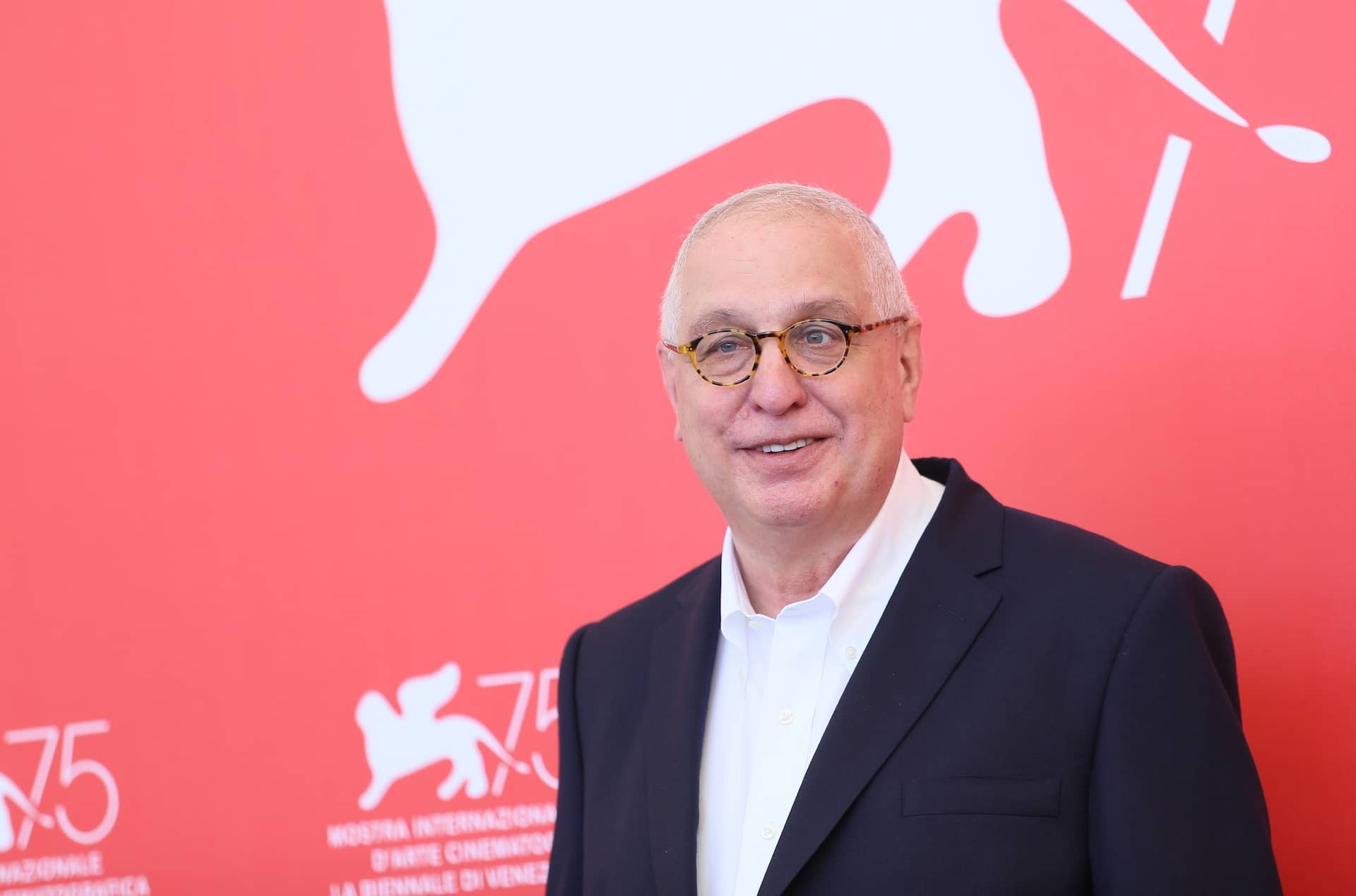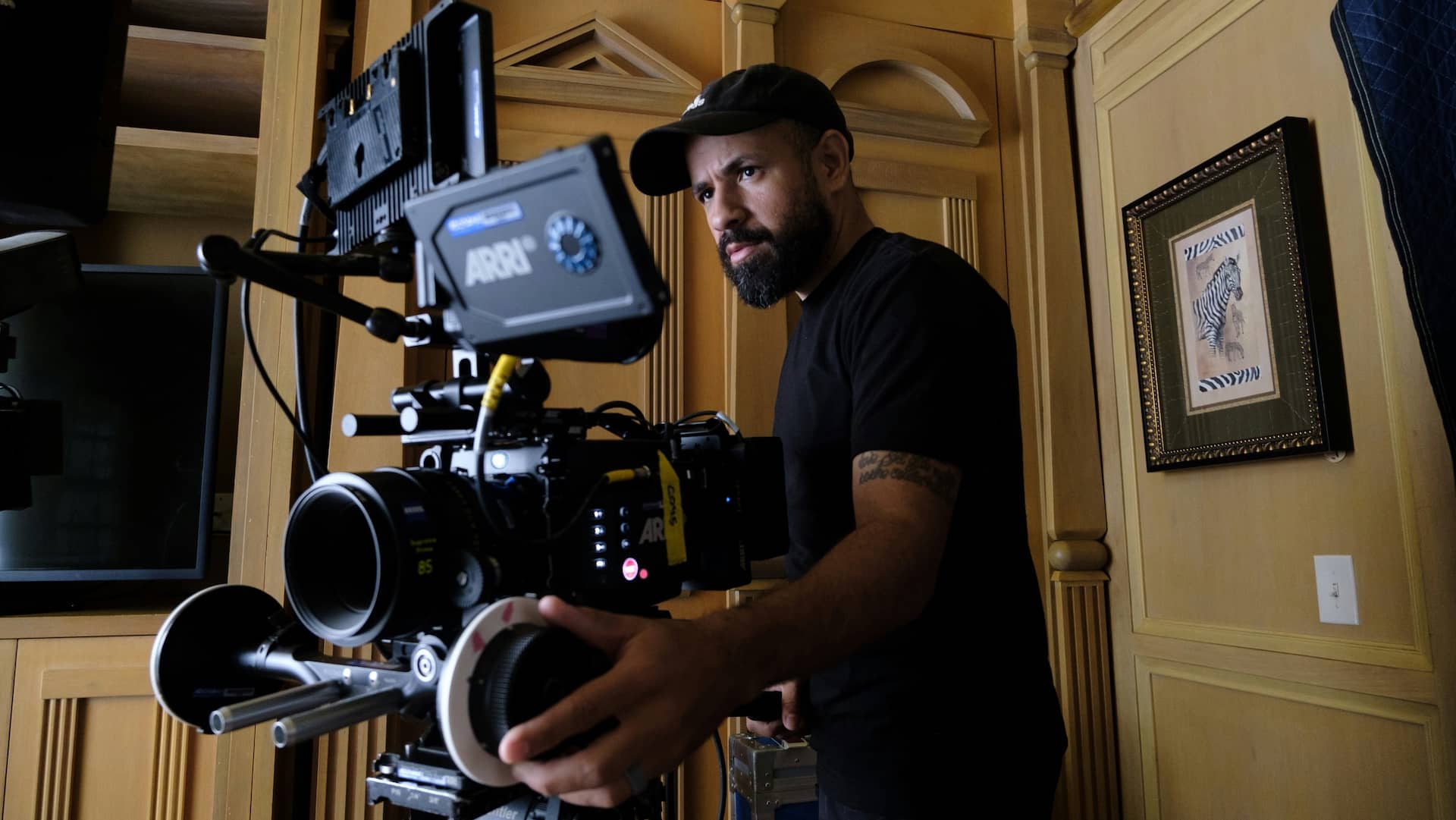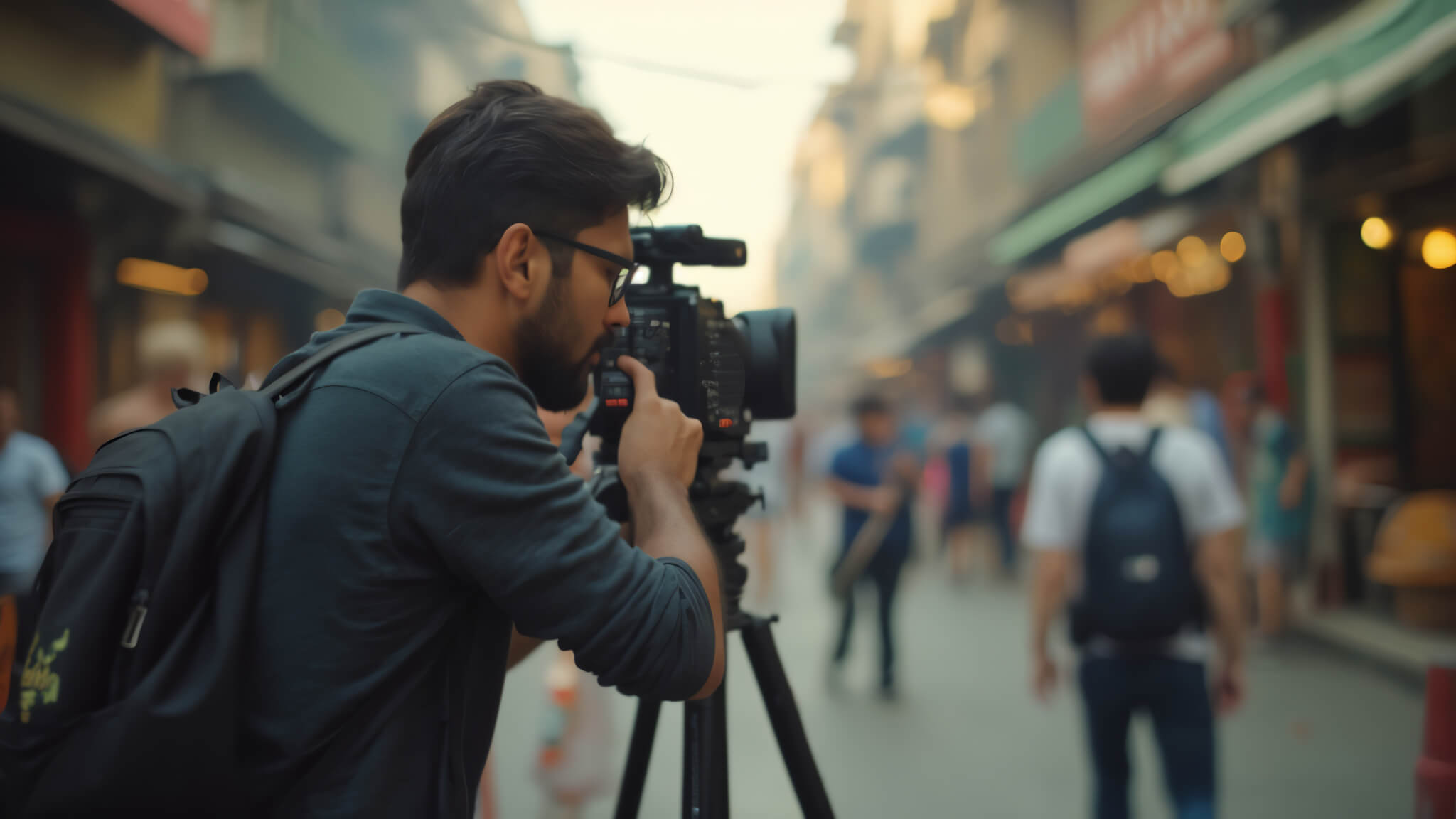Learning how to make a documentary is no easy task.
To engage in documentary filmmaking you must brave the unknown, and capture a story that unfolds in its own unpredictable way.
Although, if you are a filmmaker, then you know controlling chaos is your job.
All you need is an idea that you believe in. Along with a solid grasp of the filmmaking process, your path will soon emerge.
You’re here to learn how to make a documentary: from the selection of a compelling subject to getting it acquired by Netflix.
So let’s get into it.
Step 1: How to make a documentary: starting out
The documentary filmmaking process is an arduous one, so you need a fire burning inside that fuels the whole endeavor.
You must find a subject you care about deeply because, through telling its story, you will have to express your personal worldview.

Errol Morris, one of the great documentary filmmakers, behind the scenes
Find a worthwhile subject
Whatever it is -- global warming, civil rights issues, or someone you know personally -- consider how to make a documentary your audience will feel.
If you choose a subject that is universally accepted or boring to others, it won’t make for an engaging watch.
If your subject is something broad, narrow it down.
The acclaimed 2017 documentary Abacus: Small Enough to Jail took on the 2008 financial collapse.
But it narrowed its story to the only bank that was punished in the aftermath.
Also keep your resources in mind.
Make sure your budget allows for the access you will need to your story.
If you’re shooting a global warming documentary that requires a location shoot in Antarctica, you need to make sure that’s going to be possible.
Relate your subject to a controlling idea
Context is key in documentary filmmaking.
In addition to finding an engrossing subject, you need a bigger theme to relate it to.
In Abacus, its small story speaks volumes to why the financial collapse happened in the first place.
It examines one small bank that was punished, while major banking institutions were excused.
Director Steve James clearly lensed every shooting day with this context in mind, to capture the details that reflect this dynamic best.
Step 2: What you need when planning how to make a documentary
Once you’re firm on your subject and what you are trying to say, it’s time to hammer in your story details.
Solid research
Next step in figuring out how to make a documentary?
Research!
Documentary filmmaking is detective work, so expect to do a lot of digging.
You can start with a simple Google search.
But don’t forget about your local library whose electronic resource subscriptions might yield more thorough results.
Guide your research with your controlling idea in mind.
Like Neo spotting code patterns in The Matrix, your wider theme should dictate the data points you highlight.
Don’t just look for information that supports your thesis!
Muddy the waters with contrasting opinions and viewpoints.
You’ll likely encounter these as you interview and shoot, and they’ll add dimensionality to your message.
Now it’s time to get inspired.
To unlock what makes a good documentary, watch the great documentary filmmakers at work.
Watch their films and relate their approach to yours.
Also look for other documentaries that told a similar story as yours.
Hammer in what makes yours different.
Watch films from filmmakers like Errol Morris, Barbara Kopple, Steve James, Werner Herzog, and Nick Broomfield. Assess their filmmaking process and techniques.
Read about how they approached the question of how to make a documentary on their various films.
Finally, don’t silo yourself off during research.
Tell your friends, family and co-workers about your concept.
Be receptive to whether or not they connect with it.
Ask them what other media already out there (books, films, articles) comes to mind.
Get their feedback on how to make a documentary with this subject matter.
A thorough treatment
Now it’s time to turn your research into a story.
After you find all the data to support (and refute) your thesis, capture it all in a treatment document.
This should summarize your story and its controlling idea, and also outline the progression of events you wish to capture.
Of course, everyday reality will change the intentions that you set for your story.
Your treatment is a roadmap to keep you on track as you tackle other aspects of how to make a documentary.
Collaborators and gear
Now it’s time to think about the tools you’ll need to capture your vision, and the people to operate them.
Worry about the sound just as much as the visuals.
On a narrative film, you have the luxury of re-recording audio. But in documentaries, what you get is what you get.
So hire both a cinematographer and a sound recordist.
This way you’ll be free to concentrate on interviewees and the field events you need to capture.
Every shoot has its own technical demands. PBS POV assembled a wonderful list of documentary equipment recommended by pros, to give you a good start.
Behind the scenes look at how to make a documentary
Step 3: How to make a documentary (prep your shoot)
Now that your story’s solid, and you’re armed with the gear you need, you’re ready to set up the visuals you plan to shoot.
There’s no one way to shoot a documentary.
But, generally, the footage you shoot will fall into three categories
- Interviews with relevant subject
- Live footage you capture in the field spontaneously
- Recreated events (also known as “recreations” or “recres”)
Preparing for how to make a documentary is about laying out what you need, and being open to the natural changes that emerge.
Make storyboards and shot lists
Now you’ll need to list out all of the shots and sequences you’ll shoot. For this, you will need to make a storyboard that diagrams your intentions.
The drawings don’t need to be thorough (especially if it’s just interviews), but they will keep you and your crew organized as you shoot.

A storyboard in StudioBinder’s film production software.
Next you will want to break all of the shots of each sequence you storyboarded.
This is called a shot list, which lists out each shot, and the relevant details that go with them.
I suggest using a production management software like StudioBinder, that will combine these steps into one cohesive workflow.

StudioBinder’s shot list software
Keep watchability as your number one priority as you create your shots.
For example, you may need a lot of talking heads coverage in interviews. Keep those shots engaging with multi-camera setups, depth of field manipulation, and in-shot camera movements.
Watch this video tutorial to discover how easy and efficient the StudioBinder's Shot Lists actually are:
Make a production calendar
Now schedule everything you need to shoot. Documentaries can be a stop-and-go process, because you’re often capturing events that happen over long periods of time (even years).
So make a production calendar to keep all your tasks on one linear timeline.
StudioBinder’s production calendar lets you simply drag and drop events on a Gantt style calendar.
And if something changes, as often happens in documentaries, you can adapt with a few clicks of your mouse.

StudioBinder’s Production Calendar software
Shoot on the fly
Michael Moore posed this question to documentary filmmakers: "While you are filming a scene for your documentary, are you getting mad at what you are seeing?"
If you’re emotionally impacted while you’re shooting, then it’s more likely your audience will feel that way too.
As you shoot in the field, always consider the details the speak the most to your theme.
Capture nuances and behaviors, no matter how small. You never know what will be a useful cutaway when you sit down with your footage later.
Keep a daily log
Have a trusty “director’s log” with you as you shoot. At the end of each day, reflect on the footage you got, what went well, and what didn’t.
This is an essential documentary filmmaking tactic because it lets you analyze how well your footage is telling your story, day-to-day.
Your interviews and field photography will often give you new clues or ideas that you can pursue on the next day.
Keep track of all of those things.
Step 4: How to edit a documentary
Editing a documentary is a bit different than narrative features.
Since it is often a stop-and-go process, you’ll often get started on the edit before you’re doing shooting.
Remember, you first told your story with your concept and research.
Then you told it again (and re-wrote it) when you went out and shot it.
Now it’s time to tell it one last time with your edit.
Log your footage
To start, go through all of the footage you shot. Log the clips that relate most to your story and controlling idea.
Tools like Adobe Prelude make this process very straightforward, and include in and out points and comments on each clip.
Write an audio-visual script
Armed with the best footage you have, it’s time to work on writing a script.
Relate your footage to the beginning-middle-end structure you laid out in your treatment. Did you get everything you need?
If your budget allows, go out and grab any last shots you didn’t get.
If not, what you’ve got is what you’ve got.
There’s no single way to make a documentary script. But generally you want to break down your narration, sound and visuals into a two or three column A/V script.
Use this to plan your edit with the sights and sounds of your footage.
StudioBinder's AV Script Software makes the process of creating a list of your shots, descriptions and shot numbers so you're efficient during your shoot.
Piece it together
Reference your A/V script and logged footage as you assemble your vision. Consider using lower third graphics where a point isn’t as clearly communicated as you intended.
As you work, bring in additional family, friends or colleagues to asses what you’re working on.
Be good at soliciting and receiving feedback to make sure you’re hitting your mark.
Step 5: How to make money from documentaries
In today’s direct-to-streaming landscape, the competition for anyone’s time and money is rougher than ever.
So once you wrap your edit, you’ll need to think about how to make your documentary available to those who want to see it.
Whichever avenue you choose, you will need to come up with a crafty way of marketing yourself and your film.
Even scoring distribution does not necessarily mean any outside marketing effort will be made.
Be realistic about your expectations.
It’s harder than ever to get your film seen in theaters, but that doesn’t mean it won’t be seen by thousands, if not millions, of people.
And look to the success stories out there.
Creative North made a great video describing theirs.
Build an audience
It’s important to get yourself out there.
As you concept and shoot your film, start creating a social media presence.
Use Twitter, Facebook and Instagram to connect with accounts and organizations that relate the most to your subject.
The more interest you drum up, and the earlier on you can do it, the more attractive your documentary will become to distributors (or “buyers”).
Execute a festival strategy
Use tools like Withoutabox to start researching festivals that might be interested in your films. Try to assess whether or not they have shown films like yours in the past.
Usually festivals cost money, so only invest where you’ve got an honest chance.
Attend the festivals, and make an EPK to share when you get interest sparked.Release it yourself
If you can’t get a satisfactory offer from a distributor, it’s not the end of the world.
If you have a solid following already from social media, there are many avenues for you to release the film yourself.
The first route you can take it working with content aggregators.
These are companies such as Quiver and Distribber who distribute films to digital platforms (like iTunes, Google Play, Netflix and Hulu) often for a flat rate.
If you don’t care about the platforms and just want to sell your movie ASAP, there are a few solid self-service distribution options too.
These include Vimeo On Demand and Bittorrent Now, which let you sell your digital file directly to consumers.
You will give them a split of your revenue, but they’re pretty favorable to the filmmakers.
This is why marketing is oh-so-important.
You need to tap into your niche, so you can blast out the link to your purchasable movie to as many interested people as possible.
Wrapping up
Whether or not this is your first documentary, the path to getting it made is a winding one.
The story you cover will unfold in its own way.
Let your your subject guide how to make your documentary, and tweak accordingly.
That’s why great documentary filmmakers start with a burning desire to share their subject with the world.
Having a unified vision will allow you to adapt your filmmaking approach to the truth that you discover as you go.
Keep that initial creative spark close as you tackle the documentary filmmaking process.
And dive in deeper by exploring the end-to-end filmmaking process to cover all of your bases as you near the production phase.
And be sure to let us know what tips and techniques you use for your own productions in the comments below!
Project management for video creatives. Tasks, file sharing, calendars and more.
Manage video production timelines, tasks, storyboards, shot lists, breakdowns, call sheets. Made for video creatives, new media and film.

